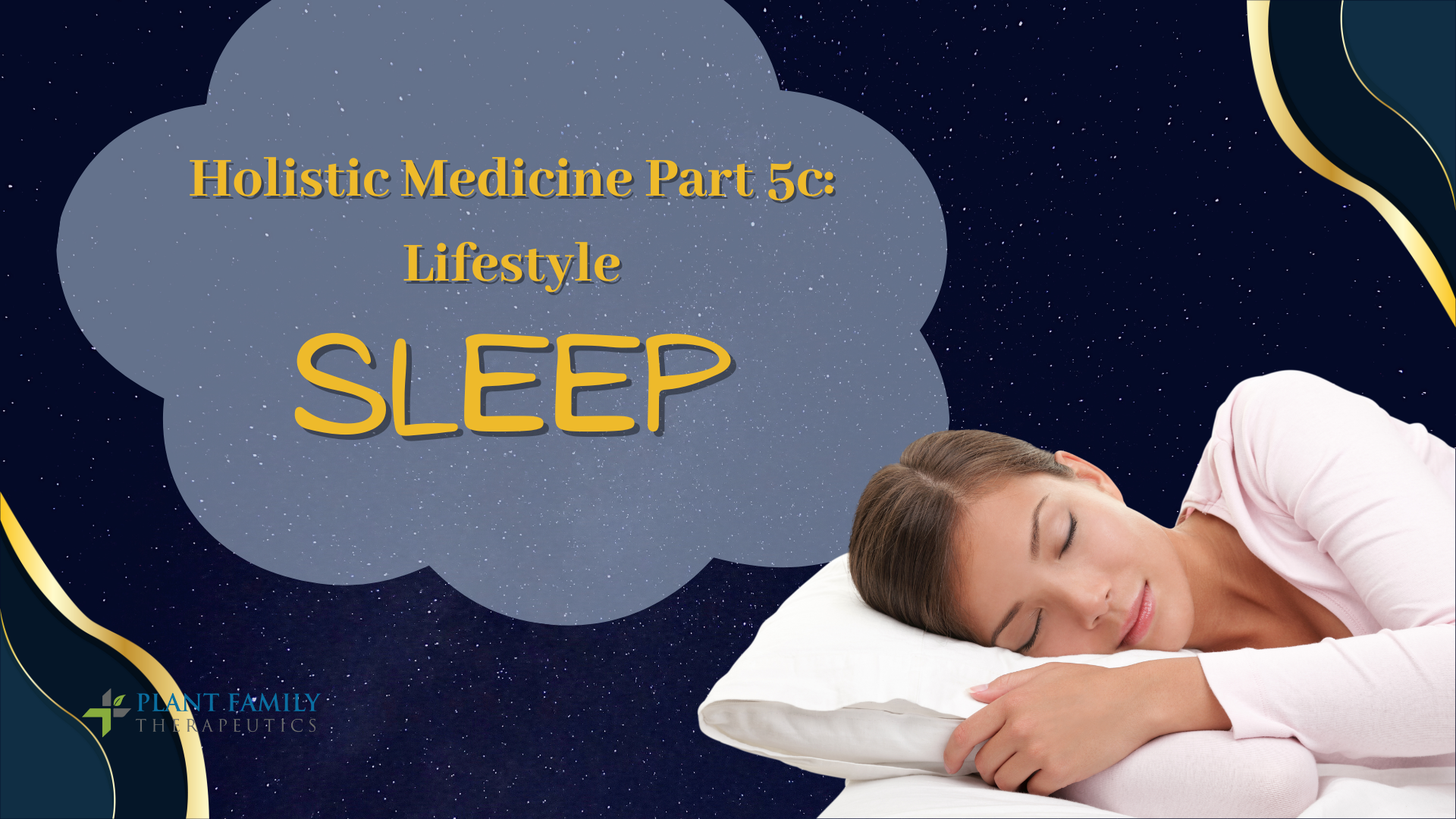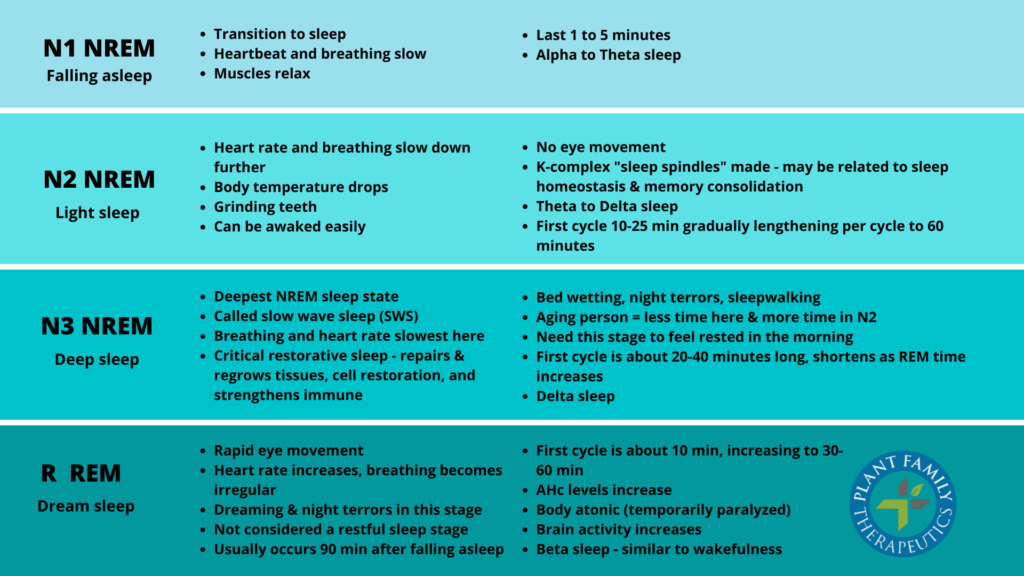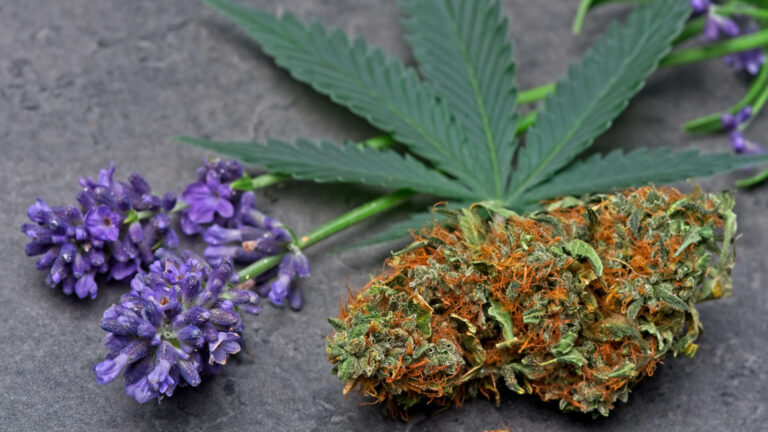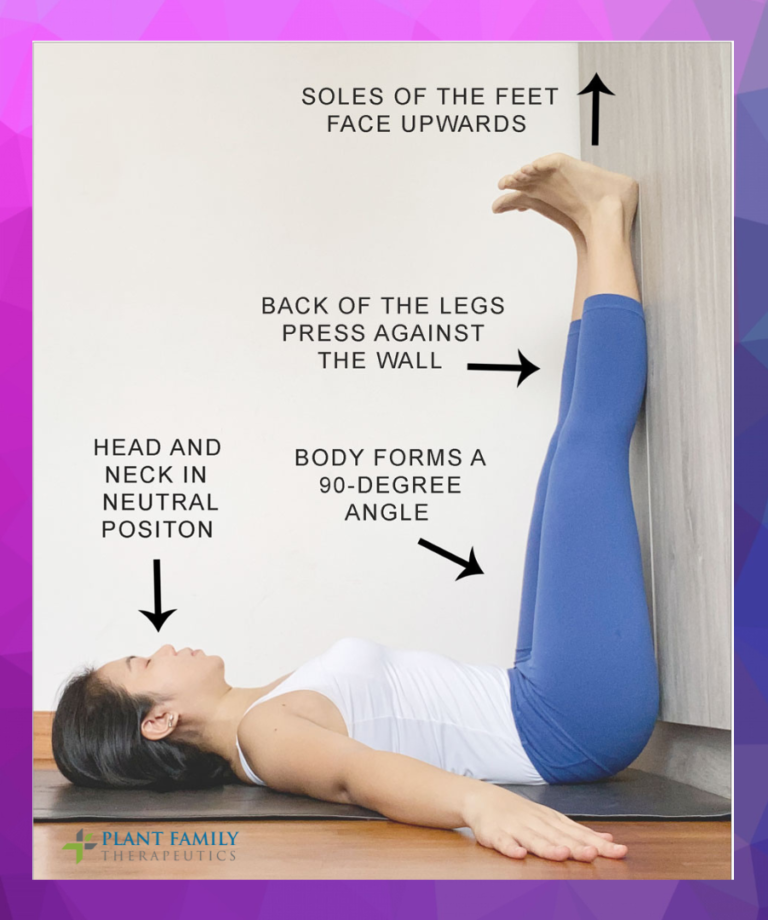This website requires you to be 21 years or older to enter. Please confirm your age below to continue.

In the last segment, the focus was on stress and how it affects the mind, body, and spirit. You may already be very aware that stress and lack of sleep can go hand-in-hand. This article is about the importance of sleep, the effects of sleep deprivation, and its role in our well-being.
There are a few things we should do each day to maintain our health including exercise, eating healthy, and drinking enough water. For some reason though, sleep doesn’t rank very high on the list, but it should. Sleep is a crucial function of the central nervous system which supports brain and body homeostasis (balance), our energy levels, our cognitive ability, and other essential physiological and mental functions.
Several studies have shown that sleep is essential for our survival, and while we are sleeping many biological processes are happening which are critical to our overall health. This is the time when our brain stores new information and rids itself of toxic waste, nerve cells communicate and reorganize, the body repairs cells, restores energy, and releases molecules like hormones and proteins.
Sleep affects all aspects of our body in one way or another. Not getting enough sleep, even for just one night, can cause several unpleasant cognitive effects like irritability, slowed reaction time, a reduction in focus and concentration, problems with memory and attention, and increased anxiety and depression.
Stages of sleep
When we are sleeping, we are in an altered state of consciousness where, depending on the stage of sleep, we have limited interactions with our surroundings. While we are physically silent when we sleep, the brain is quite busy and performs several critical tasks.
Our sleep cycles are grouped into two types of sleep stages: rapid eye movement (REM) and non-REM (NREM). NREM sleep has three sub-stages: N1, N2, and N3. Prior classification had five stages, newer classification has combined stages 3 and stage 4 as stage 3. Each stage is linked to specific brain waves and neuronal activity. You cycle through all stages four or five times a night, typically with an increasingly longer and deeper REM in the second half of the night.

How much sleep do we need?
The recommended amount of sleep depends on your age. It also varies from person to person, but the CDC suggests the following durations based on age:
birth to 3 months: 14 to 17 hours
4 to 12 months: 12 to 16 hours per 24 hours, including naps
1 to 2 years: 11 to 14 hours per 24 hours, including naps
3 to 5 years: 10 to 13 hours per 24 hours, including naps
6 to 12 years: 9 to 12 hours
13 to 18 years: 8 to 10 hours
18 to 60 years: 7 or more hours
61 to 64 years: 7 to 9 hours
65 years and older: 7 to 8 hours
What happens if you don’t get enough sleep?
Sleep affects every facet of our health and well-being. For instance, Research shows that people who do not get enough sleep gain weight, have a harder time losing weight, and or controlling blood sugar levels. Sleep deprivation increases hunger and the desire for energy-dense (fatty/high carb) meals by amplifying specific components of the endocannabinoid system (ECS).
According to a recent study, a lack of sleep increases the body’s cannabis-like chemical compounds (including anandamide and 2-AG) and activates many of the same pathways as THC and CB1 receptors, making food more appealing and rewarding.
Below are some other results noted from a lack of sleep:
Mood swings or changes in mood including anxiety and depression
Poor memory, focus and concentration
Fatigue and a weakened immune system
Chronic diseases like diabetes and insulin resistance, heart disease and high blood pressure, and an early risk for death
Increased sympathetic system activity – “fight-or-flight” response (controls your heart rate, blood pressure, digestion, urination, and sweating). Also affects the liver and immune system.
Increases inflammation/pain
ECS and Sleep Cycle
The ECS is intertwined with our circadian rhythm.
It is suggested that CB1 receptors may play a role in the generation of REM sleep and that cannabinoids could aid in REM sleep in conditions such as insomnia.
While ongoing research is not yet clear on which endocannabinoid has the greatest effect on sleep, it is speculated that both anandamide and 2-AG are involved in the process.
Studies show that 2-AG and anandamide are biphasic, meaning they have different levels and effects during different times within the 24-hour sleep/wake cycle.
Anandamide has been shown to promote sleep and increases slow-wave sleep and REM sleep.
Scientists believe when 2-AG is released into the hypothalamus, it stimulates melanin and increases REM sleep.
Cannabinoids and Sleep
Although it is becoming more and more obvious that the ECS plays a significant role in sleep and sleep neurophysiology, further studies are needed to fully grasp how cannabis may affect these processes.
Several studies have shown cannabinoids like THC and CBD (which have been used for centuries as sleep aids) induce sleep and reduce the likelihood of waking up after falling asleep in both human and rat studies. Other studies found cannabis lengthens time spent in deep, slow wave sleep, and shortens REM sleep.
Below are a few cannabinoids used for sleep.
Studies show your sleep cycle can be affected (increases sleep disturbances) by the misuse of cannabis
Known for its psychoactive or euphoric effects. This effect is what helps patients with PTSD who have nightmares/terrors while sleeping. THC also shortens the time spent in REM sleep and increased time spent in slow-wave or deep sleep = reducing dreaming
May improve breathing during sleep which may help those who suffer from sleep apnea
Helps with pain and inflammation
When it comes to THC and sleep research information is mixed. Studies show THC has sedating effects on new or infrequent users, while chronic or overuse of THC inhibited or disrupted sleep.
Study shows CBD is more effective for insomnia than THC
Helps stop racing thoughts at night
Known for reducing anxiety and depression, and for daytime mental clarity (low dose), which can be helpful with sleep
May help reduce REM behavior disorder (act out physically) in patients with Parkinson’s disease
May help REM sleep nightmares with PTSD
CBD taken during the day may help with circadian rhythm
May signal the release of feel-good hormones like dopamine and serotonin (CBD influences non-cannabinoid receptors including opioid and serotonin 1A receptors)
Works well with terpenes to create unique effects and benefits
A powerful sedative when taken with THC
Pain relieving and anti-inflammatory properties
Reduces muscular and joint pain in conditions like fibromyalgia
Decreases anxiety
Terpenes that help with sleep:
Linalool, the scent of lavender
Best as aromatherapy
Reduces anxiety and depression
Helps protect the immune system against damage from stress
Increases adenosine – a hormone that is part of our sleep cycle

Interacts with the neurotransmitter GABA which helps quiet the brain and nervous system, and reduces agitation, aggression, and restlessness
Increases time spent in slow-wave sleep
Studies show lavender helps with negative symptoms associated with sleeplessness in Alzheimer’s and dementia
Myrcene, musky clove scent
Increases sleep time
A natural muscle relaxer (“couch-lock” effect) and sleep aid
Anti-inflammatory, reduces anxiety and stress, strengthens the immune system, and anti-tumor
Regulates other terpenes and cannabinoids, enhancing the anti-inflammatory and pain-reducing effects
Helps with neuropathic-related pain
b-Caryophyllene, the smell of fresh ground pepper
Produces calming sedative effects
Helps stop racing thoughts and anxiety
Binds directly to CB2 receptors and helps with pain and inflammation – promoting better sleep.
Terpineol and b-pinene are sometimes listed as sleep aids due to their calming and pain-reducing properties. Terpineol has sedating effects, but it is usually found in Sativa strains with higher pinene. Sativas are known for their stimulation and are not good for sleep. B-pinene is listed due to its pain-reducing properties, but it is more for focus and alertness.
Below are a few sleep disorders with suggested cannabinoids and terpenes that may help. They may be used individually or combined for different effects.
Insomnia – CBD or CBN, THC, linalool, myrcene
Restless leg syndrome (RLS) – myrcene, THC, linalool, CBD
Periodic limb movement disorder (PLMD) – myrcene, THC, linalool, CBD
Apnea – THC, CBD, linalool
PTSD – THC, CBN or CBD, linalool, myrcene
Tea as a sleep aid
Tea is one of the most popular beverages consumed around the world and for good reason. Numerous studies have shown that some teas may boost your immune, fight off inflammation, and help protect you from cancers and heart disease.
Some teas contain trace elements like magnesium and potassium, as well as a variety of compounds including flavonoids like the ones below.
apigenin – helps with sleep, anxiety and depression. Anti-inflammatory, antioxidant, antimicrobial, anticancer. Activates GABA to help stimulate sleep. Supports cardiac and brain health including the reduction of b-amyloid peptide (a critical role in the onset of Alzheimer’s). Aids blocking FAAH from breaking down anandamide.
quercetin – antioxidant, anti-inflammatory, anticancer. Helps prevent heart disease, brain disorders control blood sugar, bladder infections, and diabetes. Aids blocking FAAH from breaking down anandamide.
kaempferol – antioxidant, anticancer, anti-inflammatory, brain and cardiac health. Lowers risk of Alzheimer’s. Aids blocking FAAH from breaking down anandamide.
Here are a few teas that help with sleep.
Chamomile
Passionflower
Banana tea
Valarian Root
Lavender tea
Lemon Balm
Magnolia Bark
Lemongrass tea
Other Sleep aids
Melatonin – A key sleep hormone in the sleep-wake-cycle. Not a sedative but shortens the time it takes to fall asleep and increases overall sleep quality. May increase REM sleep (dream stage) so it may not be best for PTSD.
Magnesium – Important for overall health. Helps to regulate the body’s circadian rhythm and melatonin. Can help with restless leg syndrome. Can help with stress, depression, and cardiovascular health. Note there are several types of magnesium. Magnesium glycinate = helps reduce anxiety, depression, stress, and insomnia.
Tryptophan – May help improve sleep quality and reduce time spent awake in the middle of the night. Is necessary for the formation of serotonin (a happy hormone) which plays a role in sleep induction. Tryptophan is why we get sleepy after eating turkey or drinking warm milk.
5-hydroxytryptophan (5-HTP) – A derivative of tryptophan and the precursor to melatonin. May ease symptoms of depression and anxiety.
Tart Cherry Juice – High in melatonin, increase the availability of tryptophan. Contains omega 3 & omega 6. Has antioxidant properties. May strengthen the immune system, protect against cancers, reduce blood pressure, and may help you lose weight.
L-theanine – An amino acid found in tea leaves. Promotes relaxation and facilitates sleep by affecting GABA, serotonin, and dopamine, which influence sleep. Improves daytime cognitive performance, boosts the immune system and promotes weight loss.
Almonds or Walnuts– Contain melatonin, also calcium and magnesium that lower cortisol (stress hormone). Suggested dosing 10-15 nuts about 2 hours before bed.
Kiwifruit – A study shows people who ate two kiwifruits 1 hour before bed x 4 weeks had improved sleep and took less time to fall asleep. Kiwi contains melatonin, flavonoids, magnesium and calcium to help with sleep.
The Food and Drug Administration does not regulate herbal supplements in the same way as medications, so it is important to choose a quality product from a reputable brand. Look for products that are tested by an independent lab for heavy metals, toxins, and contaminants to ensure safety.
Additionally, note that even natural sleep aids are intended to be a short-term solution. If you’re regularly experiencing trouble sleeping, it’s best to talk with a healthcare professional to rule out any underlying conditions.
It is advised to talk with your doctor before taking any supplement or sleep aid for potential interactions between other medications or your medical conditions.
Other ways to help with sleep
Unplug – Blue light that comes from electronics messes with your body’s ability to prepare for sleep. That’s right your electronics are inhibiting your melatonin and not only keeping you awake, but blue light also disrupts your circadian rhythm. So turn off your electronics at least an hour before bed and keep them away from you. Even if turned off they can affect your sleep.
Yoga – A great way to release the day, both physically and mentally. Studies show that practicing yoga regularly can help manage symptoms of insomnia, fall asleep quicker, and go back to sleep after waking up in the middle of the night. One simple pose is ‘leg-up-the-wall’ where you lay on your back with your legs up the wall.
Get a routine – Studies show changing your sleep time disrupts your circadian rhythm. Going to bed at the same time every night also helps reduce the amount of tossing and turning. The human body starts to release melatonin around 10 pm. Don’t miss out by staying up late.
Meditation/Mindfulness – Research shows meditation can help improve insomnia and improve sleep quality. Studies on people with fibromyalgia found that meditation/mindfulness helped manage anger, worry, anxiety, and depression – leading to better sleep. Here are a few types of meditation/mindfulness exercises to try.

Guided Imagery meditation – promotes relaxation by asking the meditator to imagine themselves in a calming place, such as a white sandy beach or a forest. This is often accomplished with the help of a video recording or audio clip.
Deep Breathing – Deep breathing while engaging the diaphragm is often used in combination with other meditation techniques to enhance relaxation. How to deep breathe: aim for six breaths per minute, breathe deep from the belly while expanding your abdomen and widening your rib cage as you inhale, and exhale longer than you inhale. Do this a few times and see how relaxed you feel.
Music and Frequencies
For centuries people have known that sound has a profound effect on the human body and mind. Through scientific studies, sound has been shown to reduce stress and mood swings, lower blood pressure and cortisol levels, help manage pain and improve sleep, and reduce the risk of strokes and coronary heart disease.
Music – is an abstract stimulus that can bring up feelings of euphoria similar to tangible rewards. In other words, music can stimulate dopamine release (a feel-good hormone). Besides helping you feel better, music can aid with sleep. Research shows the key features of sedative or quiet music include a tempo of 60 to 80 beats per minute, low rhythmic activity, and non-percussive elements (e.g. the sound of drums).
Brainwave frequencies are when a large number of neurons fire together (communicate) in the same rhythmic wave. The waves range from low to high frequencies. The lowest frequencies, Delta waves (0.1 to 3.5 Hz), occur in deep sleep and are associated with dreamless sleep or N3 sleep, immune, and physical and mental healing. Below is a very brief example of brainwave frequencies and their benefits.
Delta (0.1 – 4 Hz) deep, dreamless sleep, N3 NREM sleep. Immune, physical and mental healing.
Theta (4 – 8 Hz) dreamy, hypnotic, creative, intuitive, unfocused, relaxed state of mind. Good for deep meditation/spirituality. N2 NREM sleep. Memory, emotional processing, and activity of the limbic system.
Alpha (8 – 12 Hz) awake resting eyes closed, relaxed, good meditative and mindfulness state, tranquil consciousness, mental resourcefulness. Associated with REM sleep. Lowers anxiety and depressive state, helps you to think more creatively, alpha sleep helps clear unwanted thoughts and enhance your ability to absorb new information. Serotonin production (happy hormone).
Beta (12 – 30 Hz) awake, alert, focused attention, cognitive control of motor activity.
Binaural beats are two different Hertz (Hz) frequencies or tones, one played in each ear, that your brain processes as one frequency. An example of this would be listening to 210 Hz in one ear and 200 Hz in the other, your brain blends the frequencies to become 10 Hz while allowing you to hear the original frequencies as well.
The 10 Hz used in the example above happens to be an Alpha wave (8 to 12 Hz). An Alpha state of mind is associated with a state of being fully immersed in a feeling of mindfulness, relaxed, tranquil, having inner awareness of self, creativity and in a state of flow. It is also associated with the release of serotonin, a happy hormone.
Solfeggio frequencies are sound tones that can improve overall health and well-being. The tones were widely used by the Gregorian monks and in ancient Indian Sanskrit chanting because of the rhythmic pulse that had healing quantities. Solfeggio frequencies were believed to profoundly affect the conscious and subconscious mind in order to stimulate healing and promote vitality.
There are six main Solfeggio frequencies.
396 Hz – liberating one from fear and guilt
417 Hz – facilitating change and undoing situations
528 Hz – miracles and transformations like DNA repair
639 Hz – relationships and reconnecting
741 Hz – removes toxins from the body, promotes expression and solutions
852 Hz – returning one to a spiritual order
963 Hz – create room for oneness and unity.
Additional frequencies:
174 Hz – relives tension and light pain
432 Hz – creates a sense of peace and well-being, releases serotonin and endorphins (happy hormones)
Diet and Exercise
Don’t forget about the importance of diet and exercise. I have discussed both topics in the prior segments that can be found here and here.
Take away
When it comes to sleep there is a vast array of obstacles to overcome from stressful ruminating thoughts to serious medical conditions. Knowing what’s going on inside of your body including your mind will help you navigate the maze of confusion and bring a sense of understanding of why you are not sleeping. The first thing to do is assess and address any lifestyle factors that might be interfering with a good night’s rest. Is what’s keeping you up physical – like pain or twitching? Or mental like ruminating thoughts or worrying about issues out of your control?
The above information is food for thought. Don’t try everything all at once, you may end up with stimulation overload. Choose what resonates with you and give it a try for a while. Maybe you’re the type that likes to sit on the porch with a cup of tea, breathing in the night air. If so, maybe add some music to the background. Or maybe you prefer yoga followed by meditation with some aromatherapy. If you love music, you might want to choose a relaxing Indica strain to help you drift off.
Whichever you cho0se, give it time. And don’t be afraid to change it up every couple of weeks or so. The body likes to be stimulated and wants little changes here and there. It helps you grow which helps you grow in mind, body and spirit.
If you have any questions or would like more information on sleep and cannabis or your condition, visit Plant Family Therapeutics for a professional medical cannabis consultation.
In the next segment, we will start putting it all together.
References
Amutio, A., Franco, C., Sánchez-Sánchez, L. C., Pérez-Fuentes, M., Gázquez-Linares, J. J., Van Gordon, W., & Molero-Jurado, M. (2018). Effects of Mindfulness Training on Sleep Problems in Patients With Fibromyalgia. Frontiers in psychology, 9, 1365. https://doi.org/10.3389/fpsyg.2018.01365
Burattini, C., Battistini, G., Tamagnini, F., & Aicardi, G. (2014). Low-frequency stimulation evokes serotonin release in the nucleus accumbens and induces long-term depression via the production of endocannabinoids. Journal of Neurophysiology, 111(5), 1046–1055. https://doi.org/10.1152/jn.00498.2013
Cai, D. J., Mednick, S. A., Harrison, E. M., Kanady, J. C., & Mednick, S. C. (2009). REM, not incubation, improves creativity by priming associative networks. Proceedings of the National Academy of Sciences of the United States of America, 106(25), 10130–10134. https://doi.org/10.1073/pnas.0900271106
Calamassi, D., & Pomponi, G. P. (2019). Music Tuned to 440 Hz Versus 432 Hz and the Health Effects: A Double-blind Cross-over Pilot Study. Explore (New York, N.Y.), 15(4), 283–290. https://doi.org/10.1016/j.explore.2019.04.001
Caporro, M., Haneef, Z., Yeh, H. J., Lenartowicz, A., Buttinelli, C., Parvizi, J., & Stern, J. M. (2012). Functional MRI of sleep spindles and K-complexes. Clinical neurophysiology: official journal of the International Federation of Clinical Neurophysiology, 123(2), 303–309. https://doi.org/10.1016/j.clinph.2011.06.018
Cavalli, J., & RC, Dutra. (2021). A closer look at cannabimimetic terpenes, polyphenols, and flavonoids: A promising road forward. Neural Regeneration Research: 16(7),1433-1435 DOI
Costa, L. G., Garrick, J. M., Roquè, P. J., & Pellacani, C. (2016). Mechanisms of Neuroprotection by Quercetin: Counteracting Oxidative Stress and More. Oxidative medicine and cellular longevity, 2016, 2986796. https://doi.org/10.1155/2016/2986796
Dickson, GT., and Schubert, E. (2020). Musical features that aid sleep. Musicae Scientiae. https://doi.org/10.1177/1029864920972161
Drake, C. L., Roehrs, T., & Roth, T. (2003). Insomnia causes, consequences, and therapeutics: an overview. Depression and anxiety, 18(4), 163–176. https://doi.org/10.1002/da.10151
Kaul, M., Zee, P. C., & Sahni, A. S. (2021). Effects of Cannabinoids on Sleep and their Therapeutic Potential for Sleep Disorders. Neurotherapeutics: the journal of the American Society for Experimental NeuroTherapeutics, 18(1), 217–227. https://doi.org/10.1007/s13311-021-01013-w
Khansari, N., Shakiba, Y., & Mahmoudi, M. (2009). Chronic inflammation and oxidative stress as a major cause of age-related diseases and cancer. Recent patents on inflammation & allergy drug discovery, 3(1), 73–80. https://doi.org/10.2174/187221309787158371
Korte, G., Dreiseitel, A., Schreier, P., Oehme, A., Locher, S., Geiger, S., Heilmann, J., & Sand, P. G. (2010). Tea catechins’ affinity for human cannabinoid receptors. Phytomedicine : international Journal of Phytotherapy and Phytopharmacology, 17(1), 19–22. https://doi.org/10.1016/j.phymed.2009.10.001
Lorenzetti, B. B., Souza, G. E., Sarti, S. J., Santos Filho, D., & Ferreira, S. H. (1991). Myrcene mimics the peripheral analgesic activity of lemongrass tea. Journal of Ethnopharmacology, 34(1), 43–48. https://doi.org/10.1016/0378-8741(91)90187-i
Moser, D., Anderer, P., Gruber, G., Parapatics, S., Loretz, E., Boeck, M., Kloesch, G., Heller, E., Schmidt, A., Danker-Hopfe, H., Saletu, B., Zeitlhofer, J., & Dorffner, G. (2009). Sleep classification according to AASM and Rechtschaffen & Kales: effects on sleep scoring parameters. Sleep, 32(2), 139–149. https://doi.org/10.1093/sleep/32.2.139
Patel, A., Reddy, V., & Araujo, J. (2022). Physiology, sleep stages. StatPearls https://www.ncbi.nlm.nih.gov/books/NBK526132/#_NBK526132_pubdet_
Panche, A. N., Diwan, A. D., & Chandra, S. R. (2016). Flavonoids: an overview. Journal of Nutritional Science, 5, e47. https://doi.org/10.1017/jns.2016.41
Roth T. (2007). Insomnia: definition, prevalence, etiology, and consequences. Journal of Clinical Sleep Medicine: JCSM: official publication of the American Academy of Sleep Medicine, 3(5 Suppl), S7–S10. https://pubmed.ncbi.nlm.nih.gov/17824495/
Salehi, B., Venditti, A., Sharifi-Rad, M., Kręgiel, D., Sharifi-Rad, J., Durazzo, A., Lucarini, M., Santini, A., Souto, E. B., Novellino, E., Antolak, H., Azzini, E., Setzer, W. N., & Martins, N. (2019). The Therapeutic Potential of Apigenin. International Journal of Molecular Sciences, 20(6), 1305. https://doi.org/10.3390/ijms20061305
Schönauer, M., & Pöhlchen, D. (2018). Sleep spindles. Current biology : CB, 28(19), R1129–R1130. https://doi.org/10.1016/j.cub.2018.07.035
Schwartz, T. L., & Goradia, V. (2013). Managing insomnia: an overview of insomnia and pharmacologic treatment strategies in use and on the horizon. Drugs in context, 2013, 212257. https://doi.org/10.7573/dic.212257
Vaughn, L. K., Denning, G., Stuhr, K. L., de Wit, H., Hill, M. N., & Hillard, C. J. (2010). Endocannabinoid signaling: has it got rhythm? British Journal of Pharmacology, 160(3), 530–543. https://doi.org/10.1111/j.1476-5381.2010.00790.x
Vigil, J. M., Stith, S. S., Diviant, J. P., Brockelman, F., Keeling, K., & Hall, B. (2018). Effectiveness of Raw, Natural Medical Cannabis Flower for Treating Insomnia under Naturalistic Conditions. Medicines (Basel, Switzerland), 5(3), 75. https://doi.org/10.3390/medicines5030075
Yordanova, J., Kolev, V., Wagner, U., & Verleger, R. (2010). Differential associations of early- and late-night sleep with functional brain states promoting insight to abstract task regularity. PloS one, 5(2), e9442. https://doi.org/10.1371/journal.pone.0009442